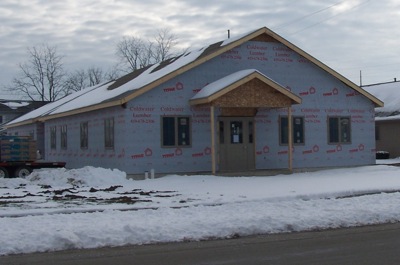Saturday, January 27th, 2007
Foreclosure impact not too serious -yet
By Shelley Grieshop
The number of foreclosure cases and sheriff sales have skyrocketed statewide and in some area counties, but the overall impact, so far, has been minimal.
Auglaize County Auditor Karyn Schumann, who handles the transfer of sheriff sales, said area foreclosures are having little affect on property values.
"I haven't seen a drop in home values at all," she said.
Foreclosed homes don't appear to be sitting empty too long. And investors who "flip" houses - buy them, fix them up and sell them - "are getting three or four times what they paid for them," Schumann says.
Most homes in Auglaize County currently are being purchased for a lot more than their recorded appraisal prices, she said. Since sheriff sale bids start at two-thirds of the appraised value, the highest bid doesn't always cover the homeowners delinquent loan.
Banks often are stuck with the "deficiency" or loss, sometimes leading them to buy back the home themselves, fix them up for resale, and keep any profits they're lucky enough to get, several local bankers said.
Predatory lenders, typically out-of-area brokers, who offer high-interest loans to risky creditors, often recoup their losses through interest payments and the high fees they charge. The profitable practice has led to a huge increase in abusive lending practices, according to the U.S. Department of Commerce.
Homelessness and other social problems have not increased in Auglaize County due to foreclosure, said Tammy Brown of Mercy Unlimited in Wapakoneta, an agency that helps area residents in need.
"Not at all," Brown said, adding that the homeless she encounters are in that situation 90 percent of the time because they are evicted from rental properties.
The most visible effect of delinquent loans locally is seen in the courts and sheriff's offices. Sue Ellen Kohler, the clerk of courts in Auglaize County, said the increase of foreclosure cases is physically evident in the filing area of common pleas court.
"We've had to deal with an increased filing space from a three-drawer standard file cabinet to a five-drawer lateral filing system just for open cases," she said. "And records are kept forever."
The number of foreclosure cases filed in local courts has increased dramatically the last five years - particularly in Auglaize County where it has more than doubled. In 2002, there were 159 foreclosure cases filed in the Wapakoneta court; in 2006 there were 358.
In Mercer County, 115 foreclosure cases were filed in 2002; 133 in 2006. Nearly all the cases involved lenders based out of the local area.
Clerks must prepare a summons on everyone involved in the case and reserve those who can't be reached. "It takes a lot of time," Kohler added.
No extra hours or staff have been added to handle the increased number of cases, but other jobs are delayed because of it, she said.
The increase in sheriff's sales also has had an impact on sheriff's departments in Mercer and Auglaize counties in recent years.
"I give my full 15 hours each week to getting ready for them, doing paperwork and getting appraisals," said Auglaize County Deputy Jim Wachauf, who retired as chief deputy last year and now exclusively handles sheriff sales at the county courthouse.
Wachauf said 35 years ago the department had less than two dozen per year. In 2006, he averaged 21/2 sales per week. The job is magnified when sheriff sales are scheduled, canceled and rescheduled.
Answers to the ongoing dilemma are slow in coming because many factors are responsible. Joblessness appears to be related - Ohio's unemployment rate was 5.6 percent in December. Mercer County posted a 3.8 percent unemployment rate for the holiday month; Auglaize County's unemployment was higher with 4.2.
The government has tried its hand at fixing the foreclosure problem in Ohio by passing legislation to stop abusive lending practices, most recently Senate Bill 185, which took effect in January. Among several things, the new legislation requires brokers, lenders and appraisers to be properly licensed, undergo background checks and use ethical standards or face penalties.
As part of the "Home buyers Protection Act," as it is called, an online database is now available to the public at www.com.state.oh.us, to seek out loan officers, brokers and non-bank mortgage lenders who have violated Ohio mortgage lending laws.
Figures mislead:
The number of home foreclosures has indeed risen in Ohio and across the country, but calculating and understanding those figures is difficult and can be misleading.
The number of court foreclosure cases is often used to show how the problem has escalated, but is not actually a true account of the number of properties lost by homeowners to foreclosure.
Why? Because while foreclosure cases are pending in court, the loan can become satisfied and the case terminated without an actual sale of the property.
An example of the discrepancy: In 2006, Mercer County 54 properties were actually sold in sheriff's sales while the common pleas court handled 133 foreclosure cases.
- Shelley Grieshop



